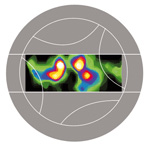Laser Induced Incandescense (LII)
 soot formation in a Common Rail 2l diesel engine
soot formation in a Common Rail 2l diesel engine
(
LII) imaging is applied using intense laser light sheet illumination slicing the (reactive) particle flow at user defined locations. The particles within the light sheet are heated up to the carbon evaporation temperature (> 4000K). The resultant incandescence (blackbody emission) of the heated particles is detected with a fast shutter camera synchronized to the laser pulse. Appropriate filtering and time-gating of the LII emission assure accurate soot volume fraction measurements. Primary particle size distributions can be derived from LII signal ratios. LII signal calibration is carried out in combination with reference sources of known particle concentrations or in combination with extinction measurements.
LII is orders of magnitude more sensitive than standard gravimetric particle sampling techniques allowing the detection of ultra low particle emissions of modern car engines even under transient conditions.
Applications:
- in-situ and real time characterization of soot
emission in diesel and direct injection spark
ignition engines, gasturbines, flames and
various kinds of metal or ceramics
- particle flows
